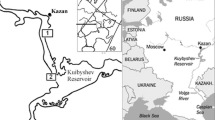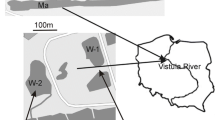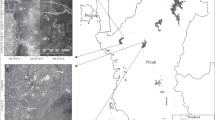Abstract
In the lakes of river flood-plain ecosystems of tropical regions, the dynamics of phytoplankton species are strongly affected by fluctuations in water level throughout the year. In Central Kalimantan Lakes, phytoplankton were dominated by heterotropic-flagellated species of Euglenophycea and Bacillariphyceae. Lakes that are frequently disturbed by flood pulses from the main river tend to have high abundance and diversity of phytoplankton, which is in line with the Junk’s Intermediate Disturbance Hypothesis.
Several factors governed the dynamics of zooplankton communities in the studied lakes. On a monthly basis, the temporal variation of zooplankton density was induced by the lunar cycle, whereas the seasonal density and biomass were determined by the alternations of wet and dry seasons. Dilution and washout effects were observed to cause zooplankton dispersal in interconnected lakes with the main river due to the increase of water currents during the rainy season, whereas the penetration of dissolved oxygen appeared to be the ultimate factor in causing different patterns of zooplankton vertical distribution in water columns of the studied lakes.
Access provided by Autonomous University of Puebla. Download chapter PDF
Similar content being viewed by others
Keywords
1 Introduction
A vast area of peatland forests cover the lowland areas of Southern Borneo (Central Kalimantan) with several large rivers meandering from north to south forming any number of oxbow and floodplain lakes alongside the rivers. The peatlands have been developed on oligotrophic kerangus soil, and are highly vulnerable to human activities.
One important factor in determining the diversity and production of the aquatic communities in the region is the hydrological dynamics in the connection of the main rivers and the lakes along the river courses the so called the “oxbow lakes”. Since the river and oxbow lakes undergo large water level changes between the dry and wet seasons, the lakes are disconnected or connected to the main river according to the water level changes. The oxbow lakes are thus classified into the following three categories in terms of the hydrological connectivity to the main river: (1) lakes connected throughout the year at both inlet and outlet, (2) lakes connected at both inlet and outlet during the high water level period but disconnected at the outlet during the low water level period, and (3) lakes connected only at the outlet during the high water level period. The following describes details of the dynamics of aquatic community in the watershed basin of Central Kalimantan that have been studied since 1998.
2 Phytoplankton Community
Composition of phytoplankton species and its abundance in oxbow lakes in Central Kalimantan varied. At lakes, such as Lutan, Takapan, and Rengas which belong to the Kahayan River system, there were 54, 49, and 38 phytoplankton species, respectively (Sulastri and Hartoto 2000). The phytoplankton species were dominated by the class of Chlorophyceae, Bacillariophyceae, and Cyanophyceae. About 10 years later, Ardianor (2010) reported from different lakes in the Kahayan River system, Tehang, Batu, and also Lutan and found that Euglenophyceae, Bacillariophyceae, and Chlorophyceae were predominant among the eight classes of phytoplankton found there. Of 96 species identified only Cryptomonas sp. and Trachelomonas volvocina were abundant in all of the three lakes. When compared with studies made in tropical river systems of South America, the numbers of species of phytoplankton in these lakes were smaller than in the Parana River system of Argentina, where ca. 270 species were reported (Garcia de Emiliani 1993, 1997; Zalocar de Domitrovic 2003), and the about 580 in the Amazon River system (Melo and Huszar 2000; Melo et al. 2004; Nabout et al. 2006, 2007).
Phytoplankton abundance of the lakes in Central Kalimantan are strongly affected by hydrological conditions, mainly fluctuations of water levels during the dry and rainy seasons. The long-term surveys in Lakes Tehang and Batu exhibited seasonal trends of phytoplankton population dynamics. Chlamydomonas sp, Cryptomonas sp., and Trachelomonas volvocina occurred throughout the year, while Peridinium sp. and Trachelomonas armata were abundant only in the flood season and Cymbella spp., Eunotia spp., Navicula spp., Euglena proxima, E. spirogyra, Phacus pleuronacles, Trachelomonas hispida, and Trachelomonas spp. were abundant only in the dry season.
Species diversity was higher and more stable in Lake Tehang than in Lake Batu. In Lake Tehang, phytoplankton were more frequently disturbed by inundation of the Kahayan River, while in Lake Batu, they were sometimes monopolized by dominant species which considerably reduced the Pielou evenness specially in the low water level season when the lake was not disturbed by water currents from the Kahayan River (Fig. 14.1). This result seems to support the intermediate disturbance hypothesis accounting for high biodiversity in unsaturated communities (Junk et al. 1989).
Seasonal changes in diversity, number of species, and evenness in Lake Tehang and Batu. Simpson’s diversity and Pielou evenness index were used as indices of diversity and evenness, respectively. Map showing Lake Tehang and Lake Batu in Central Kalimantan (After Ardianor 2010)
Physico-chemical factors also exhibited seasonal fluctuations at both lakes. Multivariate statistical redundancy analysis, RDA, showed that chlorophyll-a and diversity indices of phytoplankton were significantly correlated with water temperature, electrical conductivity, and dissolved oxygen in Lake Tehang and with water temperature and water level in Lake Batu. Further, cannonical correspondence analysis (CCA) showed that abundant phytoplankton species were significantly affected by water temperature and water level in both Lakes Tehang and Batu (Fig. 14.2). According to CCA (Fig. 14.2), some species of phytoplankton, such as Trachelomonas hispida and Eunotia spp which are found slightly abundance during low water period, seemed to have negative correlation with pH at lakes. Meanwhile, Navicula sp., Chlamydomonas sp., and Cryptomonas sp. had more negative correlation with water trenparency (SD) than others. However, Trachelomonas armata looked strongly have correlation with both water temperature and pH. Among all abundant phytoplankton species found in lakes, Trachelomonas volovocina assumed mostly adaptive and cosmopolitan species.
Cannonical correspondence analysis (CCA) applied to abundant phytoplankton species and environmental variables in (a) Lake Tehang and (b) Lake Batu. For phytoplankton species, Cy Cymbella spp., Eu Eunotia spp., Nv Navicula spp., Ch Chlamydomonas sp., Cr Cryptomonas sp., Pe Peridinium sp.; E.p Euglena proxima, E.s Euglena spirogyra, P.p Phacus pleuronacles, T.a Trachelomonas armata, T.h Trachelomonas hispida, T.v Trachelomonas volovocina, T.spp Trachelomonas spp. For each position, H high water level, L low water level; first number: month; second number: year; e.g. H6-4 high water level in June 2004. For environmental (constrained) variables, WL water level, SD Secchi depth, WT water temperature, EC electrical conductivity, pH, DO dissolved oxygen (After Ardianor 2010)
Overall, although the seasonal fluctuations in water temperature is much smaller than in rivers and lakes at high latitude, the temperature as well as water level still affects the phytoplankton communities in tropical oxbow and backwater lakes.
3 Zooplankton Community
The ecological characteristics of zooplankton community in tropical humic oxbow lake ecosystems are governed by the dynamics of the physico-chemical parameters in the aquatic ecosystem. The changing of physico-chemical parameters is due mainly to the seasonal changes in water hydrology in a region. Zooplankton communities can be classified into three major groups, rotifers, cladocerans, and copepods (Fig. 14.3). Among rotifers, several genera such as Testudinella, Lepadella, and Lecane were commonly found. Cladoceran communities consist mostly of Bosminopsis, Alona, and Euryalona, whereas copepod communities are dominated by Mesocyclops. The thermocyclops brevifuracatus species was the most common copepod species found. In all studied lakes, the number of identified rotifers was 119 species.
In all studied lakes, zooplankton communities exhibited considerable temporal and seasonal fluctuations in density and biomass. Over a 1-month period, larger-sized zooplankton in isolated lakes especially cladocerans, tended to decline in density during moonlight periods. Rotifers tended to increase in density during the decline of cladocerans. The density of cladocerans was correlated negatively with the rotiferan density (Fig. 14.4).
Aerial population densities (102 individuals m−2) and depth-time isopleths of densities of cladocerans plotted for three dominant rotiferan genera (individuals l−1) at the center of Lake Tundai during 12 November to 9 December 1999. Top panel indicates the lunar cycle (left), and the relationships between the abundances of cladocerans (y axis) and rotifers (x axis) at the centre of Lake Tundai (right)
It is presumed that the inverse density relationship between cladocerans and rotifers is due to the effect of the lunar cycle on fish feeding intensities upon larger-sized zooplankton according to the size selective predation mechanism (Brooks and Dodson 1965). Since a lot of fish were also found in the lake (Doi et al. 2000) it is very probable that these fishes feed intensively on zooplankton. These fishes locate their prey visually and their predatory success is a function of prey size and underwater light intensity (Tilzer 2000).
Over a 1 year period, most lakes exhibited similar patterns of fluctuations in zooplankton density and biomass. Zooplankton density and biomass were very low during the rainy season, and then increased strongly during dry season from July to October (Fig. 14.5).
Although the seasonal fluctuations of zooplankton density were very similar, different mechanisms appeared to govern the dynamics and the successions of zooplankton in different lakes with different hydrological connectivity to the main rivers. In a lake which is completely isolated from the main river, the increase in zooplankton density during low water levels seemed to be induced by the increase of available food after the rainy season, as indicated by a significant positive correlation between rotiferan density and chla or DOC (Table 14.1).
Previous studies by other workers (Mavuti 1990; Piyasiri and Chandrananda 1998) have reported that nutrient loading from surrounding areas during the rainy season is a common phenomenon in tropical lake systems. These nutrients could stimulate the growth of phytoplankton, which is in turn consumed by zooplankton for growth and reproduction.
In lakes that were occasionally connected both in inlet and outlet to the main river, the mechanism is slightly different. During high water levels, water from the main rivers usually enters the lake from two different channels: inlet and outlet, and that leads to the increase in water currents in the lakes. This water current will lead to the dilution and washout effects that promote zooplankton dispersal from one lake to the main river or from one lake to other adjacent connected lakes. In four interconnected lakes along the Kahayan River (Fig. 14.6), these dilution and washout effects were clearly detected.
Significant dispersal coefficient directions were found between the three interconnected lakes: Batu, Tehang, and Bunter. Between Lake Batu and Lake Tehang significant dispersal coefficients were observed during November (χ 2 = 8.0, P < 0.01), December (χ 2 = 5.56, P < 0.05), and July (χ 2 = 6.4, P < 0.05) whereas those between Lake Tehang and Lake Bunter occurred in September (χ 2 = 9.0, P < 0.01), November (χ 2 = 13.76, P < 0.01), and January (χ 2 = 6.25,P < 0.05).
Zooplankton communities in Kalimantan lakes could also exhibit very different patterns in the vertical distribution. In isolated lakes, zooplankton tended to be concentrated only in the layer from the surface down to 2 m depths throughout most of the year, whereas in open connected lakes, zooplankton was also found to be distributed vertically from the surface down to the bottom of the lake (Fig. 14.7). This difference in zooplankton vertical distributions was controlled by the lake mixing pattern and the distribution of dissolved oxygen in water columns between lakes.
References
Ardianor (2010) Environmental factors affecting lacustrine phytoplankton community dynamics in Central Kalimantan, Indonesia. A Ph.D dissertation of Graduate School of Environmental Science, Hokkaido University, Japan. 96 p
Brooks JL, Dodson SI (1965) Predation, body size, and composition of plankton. Science 150:28–35
Doi A, Komatsu R, Hartoto DI (2000) Fish occurring in a black water oxbow lake in South Borneo. Rep Suwa Hydrobiol Shinshu Univ 12:25–38
García de Emiliani MO (1993) Seasonal succession of phytoplankton in a lake of the Paraná River floodplain, Argentina. Hydrobiologia 264:101–114
García de Emiliani MO (1997) Effects of water level fluctuations on phytoplankton in a river-floodplain lake system (Paraná river, Argentina). Hydrobiologia 357:1–15
Junk WJ, Bayley PB, Sparks RE (1989) The flood pulse concept in river floodplain systems. Can Spec Publ Fish Aquat Sci 106:110–127
Mavuti KM (1990) Ecology and role of zooplankton in the fishery of Lake Naivasha. Hydrobiologia 208:131–140
Melo S, Huszar VLM (2000) Phytoplankton in an Amazonian flood-plain lake (Lago Batata, Brasil): diel variation and species strategies. J Plankton Res 22:63–76
Melo S, Huszar VLM, Roland F, Esteves FA, Bozelli R (2004) Phytoplankton diel variation and vertical distribution in two Amazonian floodplain lakes (Batata Lake and Mussura Lake, Para-Brasil) with different mixing regimes. Amazoniana XVIII(1/2):1–10
Nabout JC, Nogueira IS, Oliveira LG (2006) Phytoplankton community of floodplain lakes of the Araguaia River, Brazil, in the rainy and dry seasons. J Plankton Res 28:181–193
Nabout JC, Nogueira IS, Oliveira LG, Morais RR (2007) Phytoplankton diversity (alpha, beta, and gamma) from the Araguaia River tropical floodplain lakes (central Brazil). Hydrobiologia 557:455–461
Piyasiri S, Chandrananda WPN (1998) Studies on the population structure of zooplankton in the Kotmale Reservoir. J Natl Sci Counc Sri Lanka 26:59–76
Sulastri, Hartoto DI (2000) Distribution of phytoplankton in some oxbow lakes of Central Kalimantan. In: Tropical Peatlands. Proceedings of the international symposium on tropical peatlands, Bogor, Indonesia, November 1999
Tilzer MM (2000) Control factors of planktonic population dynamics in freshwater: a review. Arch Hydrobiol 55:47–491
Zalocar de Domitrovic Y (2003) Effect of fluctuations of water level on phytoplankton development in three lakes of the Parana’ River floodplain (Argentina). Hydrobiologia 510:175–193
Acknowledgement
Results shown in this paper were mainly obtained from SATREPS (Science and Technology Research Partnership for Sustainable Development) project entitled as “Wild fire and carbon management in peat-forest in Indonesia” founded by JST (Japan Science and Technology Agency) and JICA (Japan International Cooperation Agency).
Author information
Authors and Affiliations
Corresponding author
Editor information
Editors and Affiliations
Rights and permissions
Copyright information
© 2016 Springer Japan
About this chapter
Cite this chapter
Gumiri, S., Ardianor, Higashi, S., Iwakuma, T. (2016). Aquatic Communities in Peatland of Central Kalimantan. In: Osaki, M., Tsuji, N. (eds) Tropical Peatland Ecosystems. Springer, Tokyo. https://doi.org/10.1007/978-4-431-55681-7_14
Download citation
DOI: https://doi.org/10.1007/978-4-431-55681-7_14
Publisher Name: Springer, Tokyo
Print ISBN: 978-4-431-55680-0
Online ISBN: 978-4-431-55681-7
eBook Packages: Earth and Environmental ScienceEarth and Environmental Science (R0)











